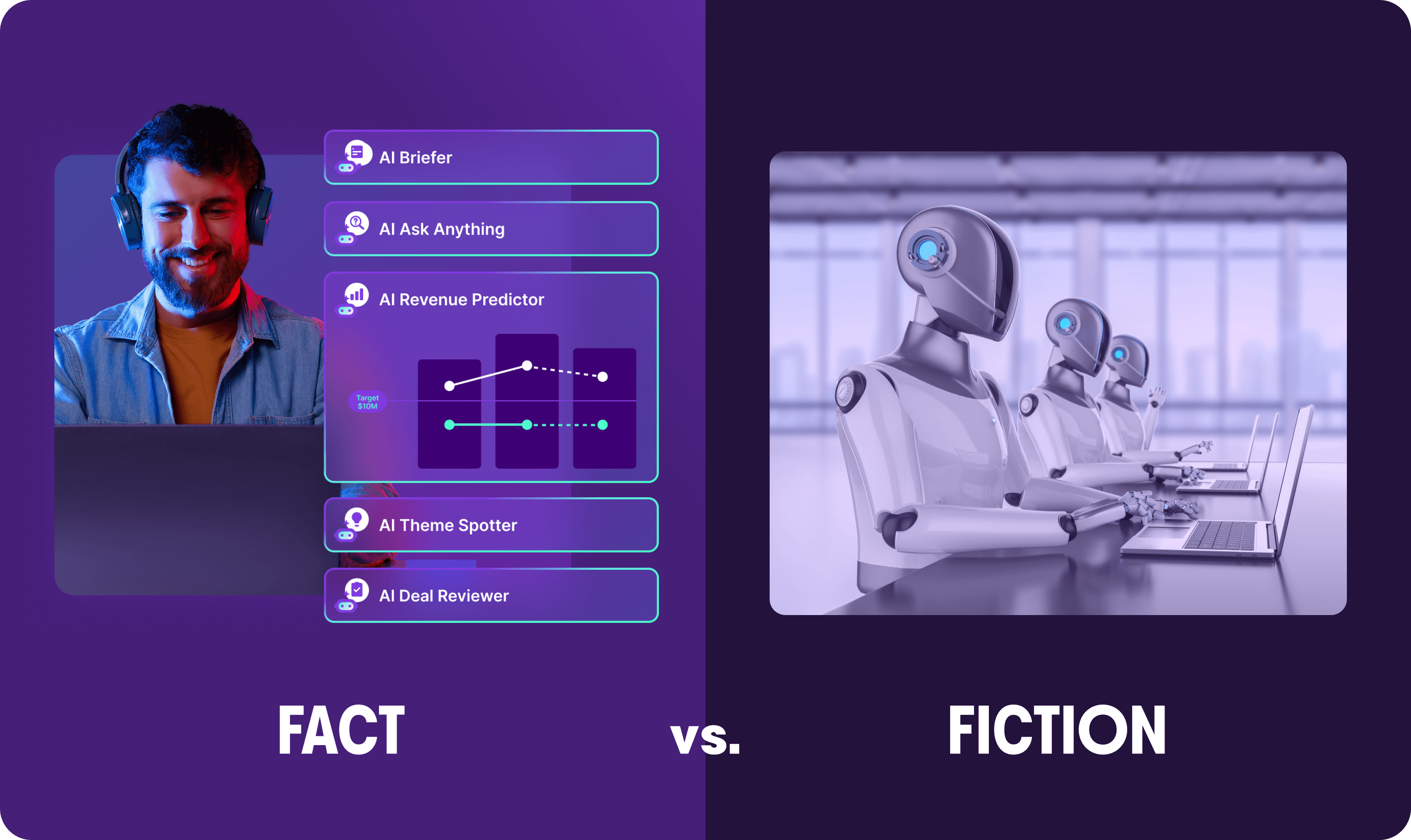Sales strategies
Unlocking successful target account selling: strategies for big wins

Jonathan Costet
Content Author
Published on: December 14, 2022
High-value deals are the holy grail for B2B sales managers. But they aren’t easy to come by. If you want to win enterprise-level six-figure deals, you need an enterprise sales strategy .
You need a strategy that trades quantity for quality. One that has your sales reps focus only on the very best leads. One that sees your reps become trusted consultants.
It’s time to talk about target account selling, or TAS.
Target account selling is a highly personalized, targeted approach to sales that sees your sales reps focus only on the very best accounts. It can be time-consuming at first (since you’ll need to gather a lot of information), but the pay-offs can be huge.
With that in mind, let’s examine what exactly target account selling is and how you can start executing it in your sales strategy today.
What is target account selling (TAS)?
Target account selling is a B2B sales methodology that focuses on building and nurturing relationships with strategically chosen, high-value accounts that have a high probability of closing.
What makes these accounts likely to close? Well, they closely match your ideal customer profile (ICP) and characteristics with your top buyers.
Target account selling makes accounts even more likely to close by encouraging reps to personalize every interaction throughout the buying process and building long-term partnerships between the buyer and the seller.
Naturally, all this personalization makes target account selling fairly research-intensive, which is why some salespeople consider it a waste of time. But, as you’ll see below, it can be an incredibly profitable sales methodology when done right.
What are the benefits of target account selling?
Target account selling offers three major benefits for sales teams willing to put in the work.
Move upmarket
I’m willing to bet that the difference in sales cycle length between your smaller deals and larger deals isn’t much. So why are you wasting time and resources on smaller deals when you could be pursuing much more profitable ones?
If the reason is that you can’t add them to your pipeline, target account selling may be the answer. It’s one of the most effective ways of moving upmarket to target bigger and better buyers.
Part of the reason target account selling lets you move upmarket is that you can spend the time needed to convert high-value accounts.
But the TAS process makes you more attractive to these accounts, too. The personalized service that sales reps deliver also improves your company’s reputation. The more buyers who rave about your service, the more attractive to enterprise clients you’ll become.
Less time spent on poor-quality accounts
By its nature, target account selling ensures that your sales reps only spend time on top-tier accounts. Sales reps don’t waste time chasing low-quality leads that won’t close or whose annual contracts are barely worth their time.
This isn’t a numbers game — it’s about quality over quality.
Achieve higher annual contract value (ACV)
You’ll generate fewer deals when you use target account selling, but those deals will have a significantly higher annual contract value than previous deals.
That’s because you’re removing all of the small deals from your funnel and focusing on the whales — those sales that bring in the bulk of your revenue. Target account selling is the perfect strategy to win high-value, complex sales with multiple decision-makers.
How to implement a target account selling methodology in 5 steps
Now you know the benefits, here’s how you can execute a successful TAS strategy.
1. Create ICPs and buyer personas
It’s essential to know what your target account looks like when running a TAS strategy. So the first step is to create detailed ICPs and buyer personas (also known as customer personas).
An ideal customer profile details the firmographic, behavioral, and environmental qualities of your top buyers. These are things like the buyer’s industry, revenue figures, and pain points.
Ask the following questions to create an ICP:
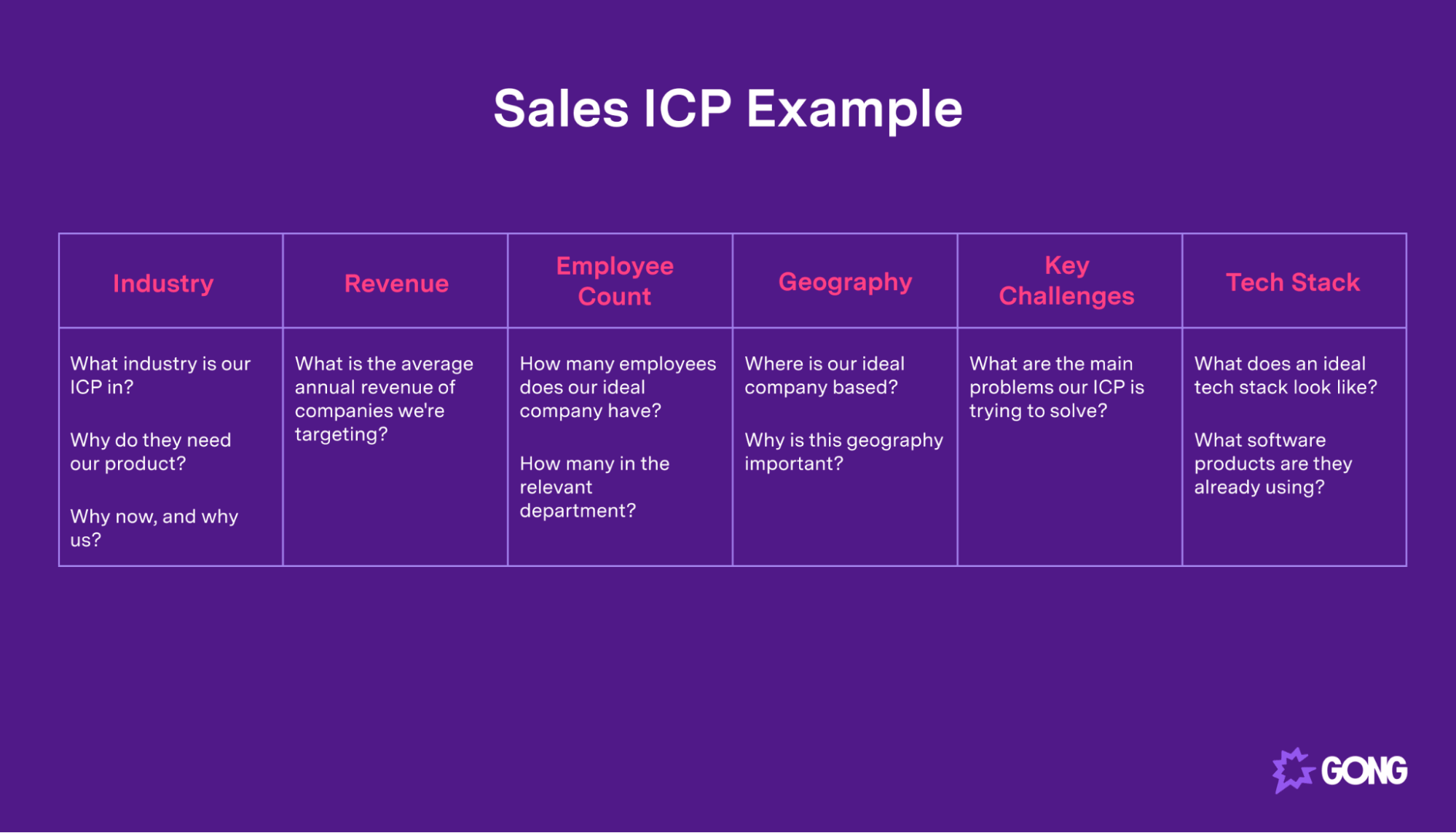
A buyer persona describes the decision-makers your team will be reaching out to. It’s much more qualitative than an ICP and includes information like the buyer’s job title, challenges, and goals.

Use information about your most successful accounts to create both your ICPs and customer personas. But don’t just stop at quantitative data. Ask your current buyers why they chose your solution, what pain points you solved, and which competitors they were considering.
Make your ICPs and customer personas as detailed as possible.
The idea is that you only target accounts that match them because those accounts are the most valuable. While you don’t want to make them so detailed that only five companies in your market match them, you also don’t want to leave any doubt as to what a good account looks like.
2. Build a target account list
A target account list is a list of the companies your sales reps will be targeting.
If you’ve created detailed ICPs and personas, this list should be pretty easy to create. Only include companies that are a genuine match — you want to prioritize quality over quantity.
Encourage your reps to learn as much as they can about these accounts and the people who work at them. Check out LinkedIn profiles. Look up the companies on Crunchbase or other data sources. You can even ask existing clients to give you referrals.
You’ll want to prioritize accounts at this stage, too. You can do this according to the following criteria:
- How closely they match your ICP
- The potential value of each deal
- The amount of information you have about them
- Your sales reps’ expertise
- How likely they are to buy from you
Try to strike a balance with the number of accounts on your team’s list. Too few accounts will limit your reps’ potential sales. Too many, and your team won’t be able to dedicate the time they need to close each account.
3. Reach out to targets
With a target account list at their disposal, reps need to start making contact with each account. Personalization is essential when you’re only speaking with a handful of accounts.
Cold calling is the best way to reach out to the target accounts on your list. But don’t burn through them — you need to make each conversation count. That’s why it’s important to follow our favorite outreach tips .
When opening, start by using your full name and the company you’re calling on behalf of. This commands respect and establishes that you’ll be the person leading the conversation.
Next, state the reason for your call.
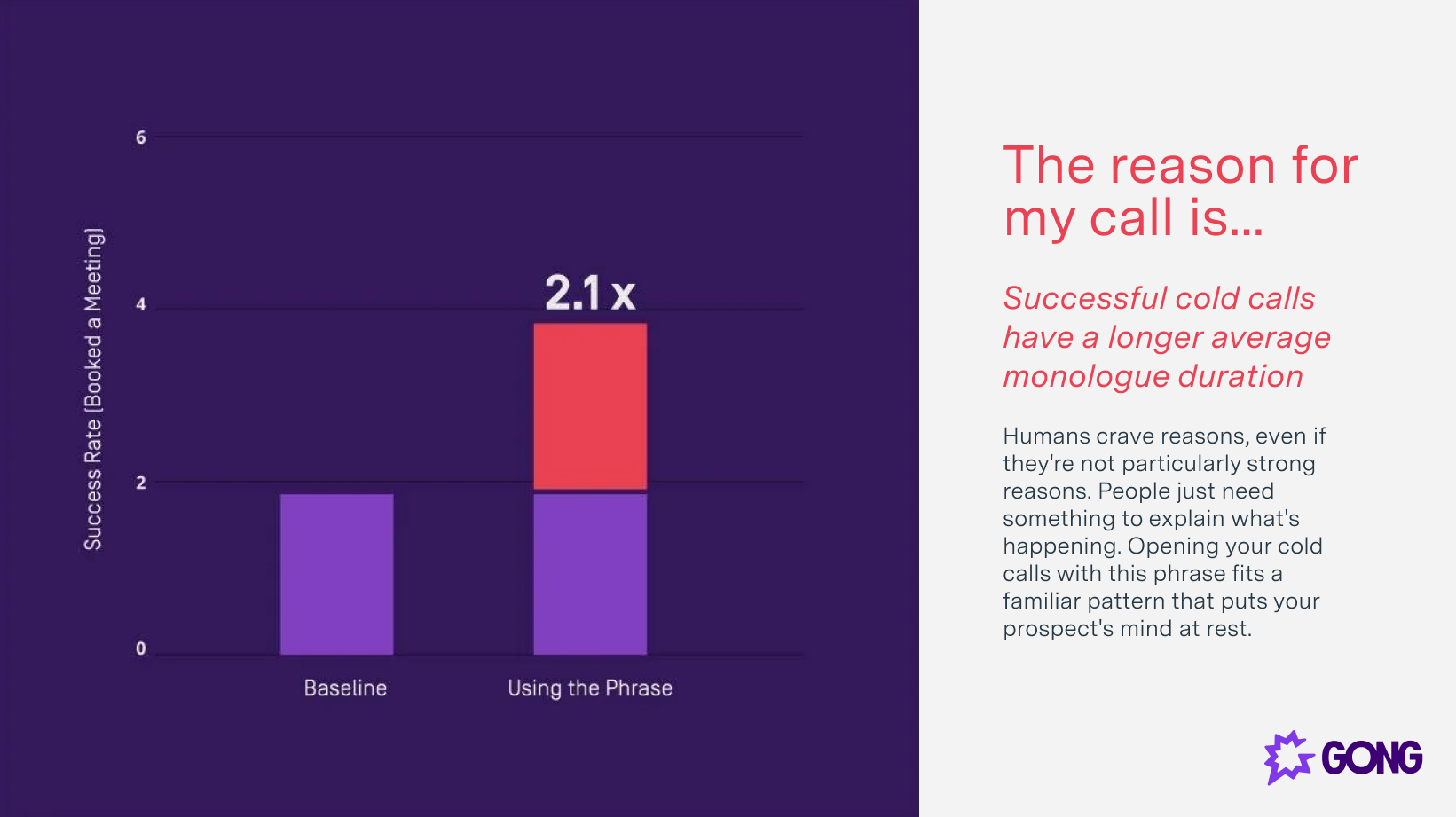
Our research shows that stating your reason for calling can increase your success rate by 2.1x. Not bad for one sentence.
Don’t get carried away, however.
We recommend not doing discovery on your first cold call. You want to sell the meeting so that you can gather information. And to do that, you need to talk more — the optimal talk-to-listen ratio for successful cold calls is 55:45.
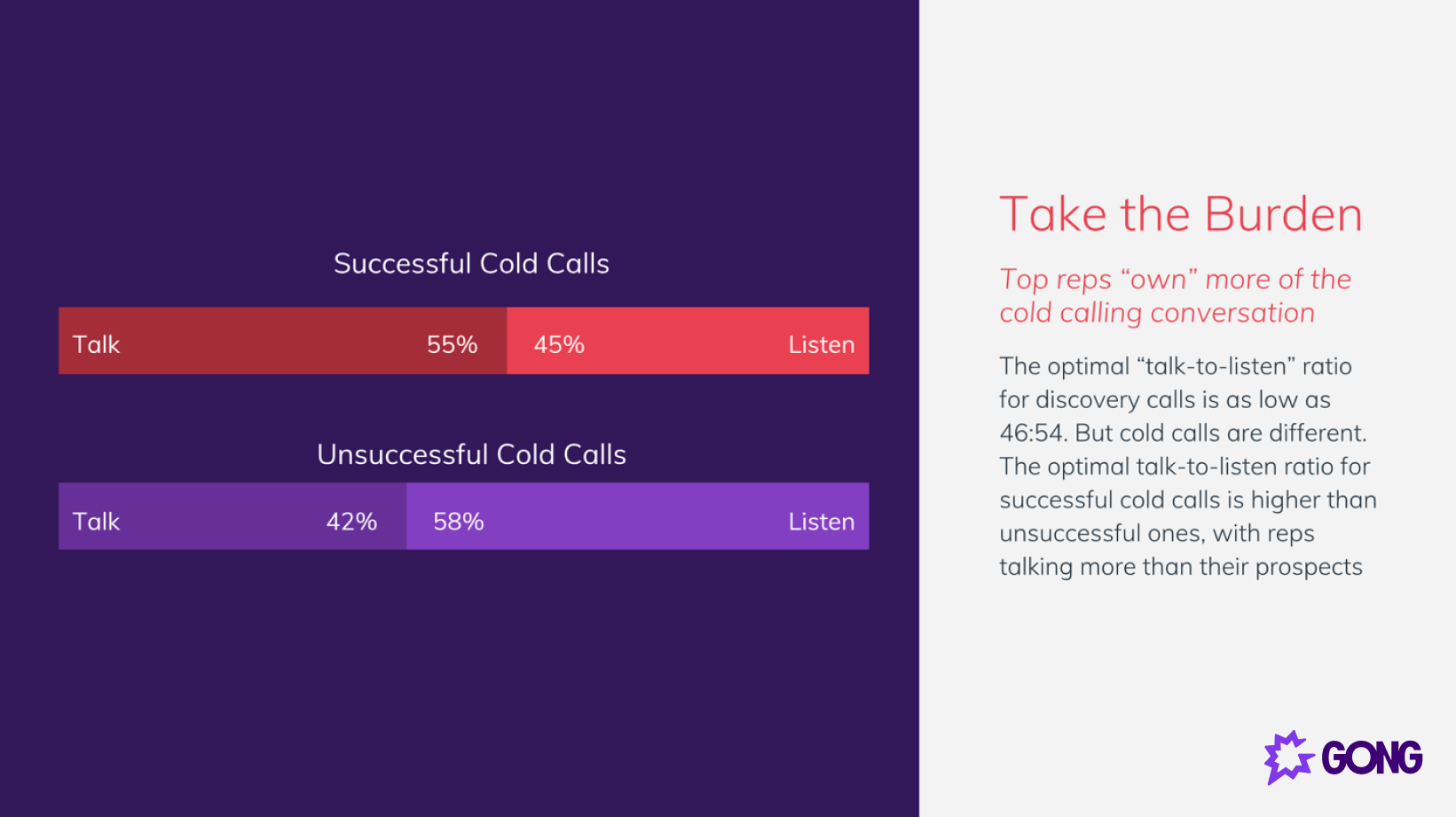
That’s why the best reps speak more than the buyer on the first call. Our research shows that successful cold callers spend more than half the call talking.
4. Nurture every stakeholder
The consultative approach used in target account selling means sales reps need to spend alotof time nurturing buyers. Because your sales team is targeting high-value enterprise accounts, this will often require them to nurture multiple decision-makers simultaneously.
The more buyers your reps involve in the process, the more likely they’ll close the deal. Winning deals have at least three people from the buyer’s side involved in meetings.
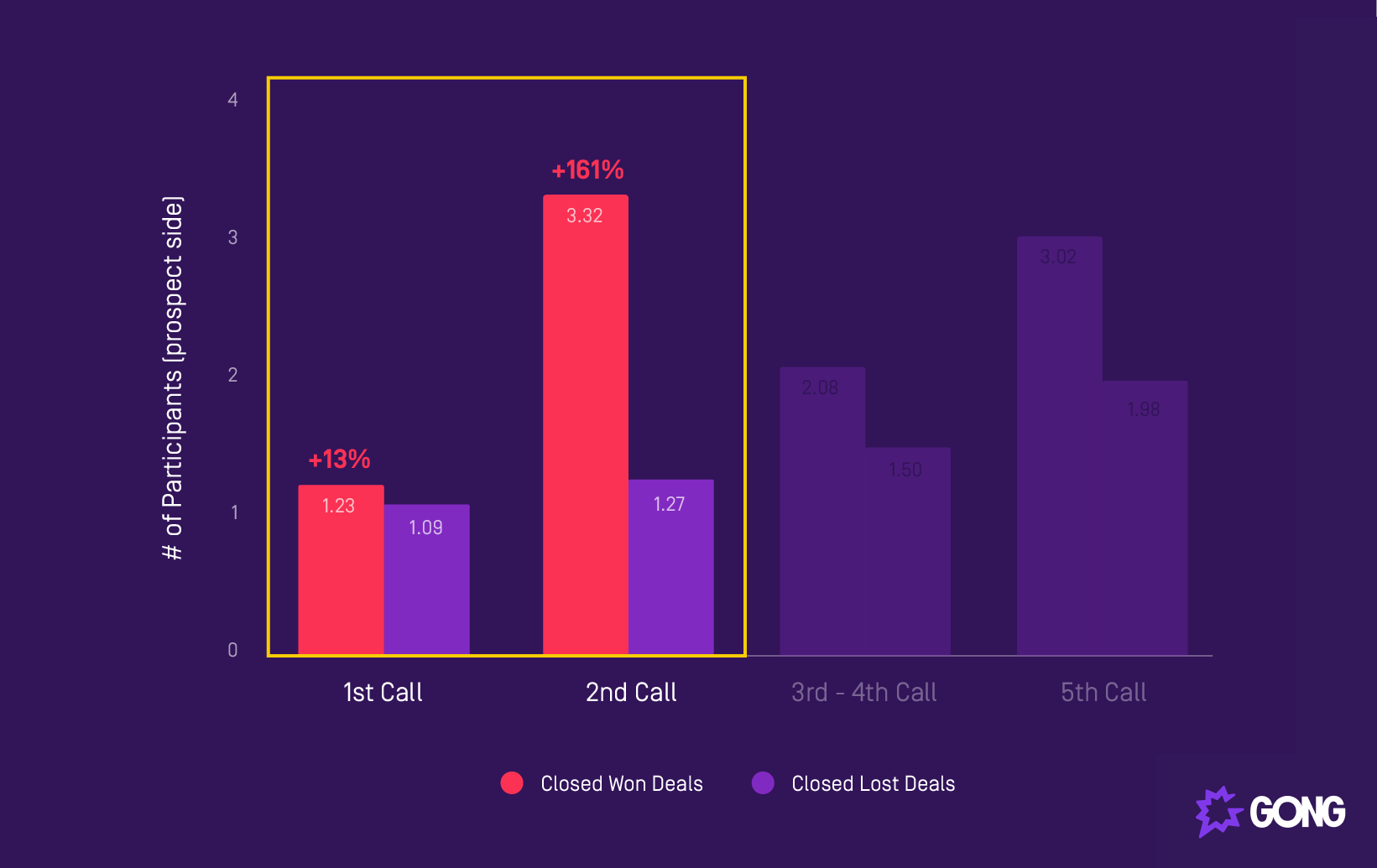
What’s more, the more people you involve in a deal, the higher value that deal will be.

Deal value increases when more buyers are involved in the sales cycle. That means your team will need to build multiple case studies.
The importance of research in target account selling
Even if you know the steps to a successful target account selling strategy, you still need to get your research right.
Account intelligence
Account intelligence is all of the information your reps can find about their target accounts — the list of companies that match your ICP.
Your reps can do a lot of research before picking up the phone. LinkedIn, Crunchbase, and other sales data sources are the perfect places to start.
Market intelligence
Does your sales team know what’s happening in the wider market, away from your products and your competitors? They should.
Your sales team need to be informed about things like:
- The economy
- Market disruptions
- New advances in technology
- Changing consumer habits
Industry reports are a fantastic source of market intelligence. Yes, some of them can be expensive, but there are plenty of reports you can get for free (or in return for your email address).
Competitive intelligence
Unlike other sales methodologies , target account selling requires you to be knowledgeable about your competitors as well as your own product.
Your competitors’ websites, social media profiles, and marketing resources are all treasure troves of information. But don’t be scared to think outside the box. Maybe the company’s head of sales or marketing has been a podcast guest. Maybe someone from the company has been featured on a webinar talking about their product.
You can also reach out to current clients to see if they’ve spoken to your competitors at the same time they’ve spoken to you.
Primary research
All of the research your team has gathered so far is third-party research based on what other people have compiled. Now it’s time for you and your team to do your own research.
This research starts with the data in your own CRM — data that will form the basis of your ICP and customer personas. You want to discover similarities between your best accounts.
For instance:
- What industry are they in?
- What pain point did you solve?
- Who did you speak to?
- Where are they based?
Primary research also includes all of the information that your sales team discovers during prospect calls with buyers. This will help them fill in the gaps in their ICPs, identify pain points, and discover other nuggets of information they can use to personalize their pitch.

Be careful to avoid asking too many questions, though. Our research shows that 11–14 is the perfect number of questions per call.
Go-to-market outreach
You need to have a strong, sales-led, go-to-market strategy to succeed with target account selling. Your GTM strategy will be a clear step-by-step roadmap for launching your product. It will outline which accounts you prioritize and how you nurture them.
Go-to-market outreach requires you to develop messaging and craft a promotional strategy — both of which will help your sales reps better position your product to clients.
Move upmarket with Gong
Target account selling is successful because of the sheer amount of research it requires reps to do. But that doesn’t mean there isn’t a place for sales software in a TAS strategy. Far from it. You need sales software to ensure your reps are following the research-backed, high-touch, personalized process that target account selling prescribes.
In particular, you need Gong.
Gong makes it easy to understand your reps’ behavior and turn their conversations into coachable moments . So you don’t just get to make sure your reps are on track, but you also get automated insights that spot problem patterns and real-life examples of where those reps can improve. Book a demo to find out more.

Content Author
Jonathan Costet is the Senior Director of Revenue Marketing at Wiz. Before this, he was Senior Manager, Growth Marketing at Gong, where he played a crucial role in driving demand generation through data-driven strategies. At Gong, Jonathan harnessed the power of revenue intelligence to craft effective messaging, improve customer retention, and optimize sales forecasting. He was instrumental in using Gong's platform to unlock insights that helped target the right buyers and maximize marketing efficiency.
Discover more from Gong
Check out the latest product information, executive insights, and selling tips and tricks, all on the Gong blog.



